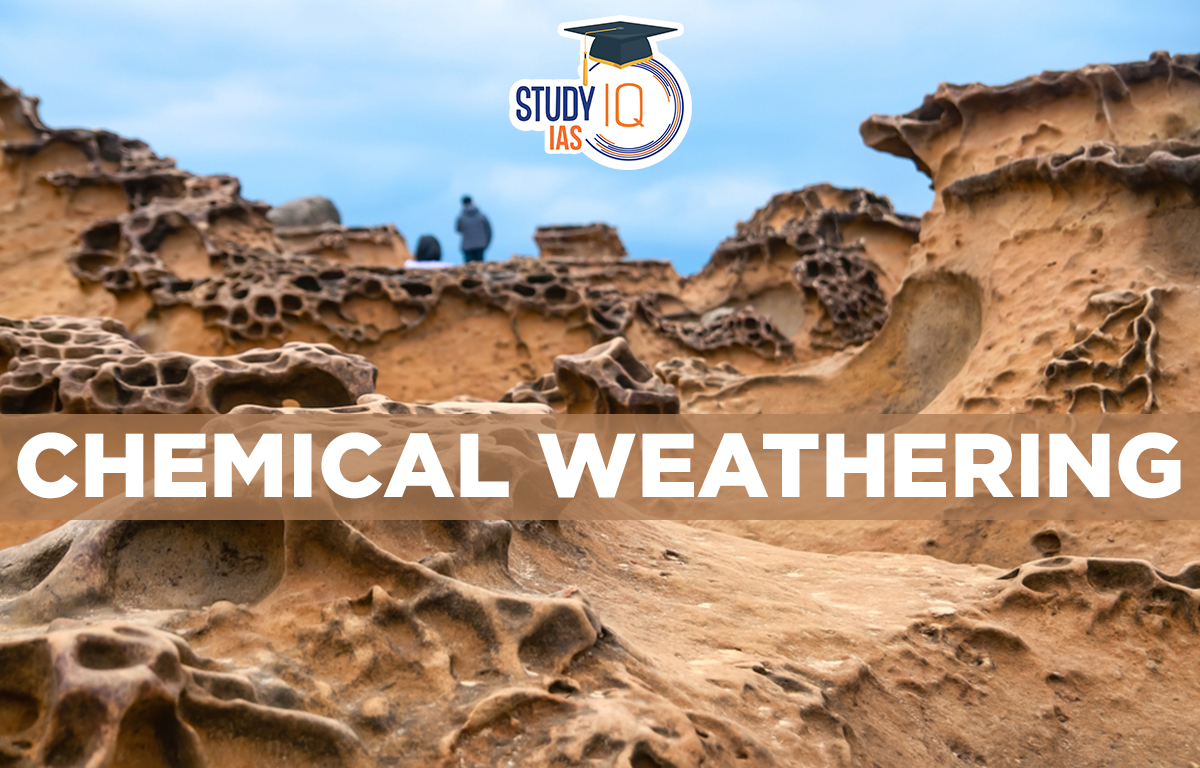Table of Contents
Chemical Weathering
Chemical weathering breaks down rocks through reactions between minerals and the environment. Here are some examples:
Water: Water is the main cause of chemical weathering. It reacts with minerals like feldspar to form clay.
Acids: Water contains weak acids, like carbonic acid, which forms when carbon dioxide mixes with rainwater. Other acids can come from sources like power plants and volcanoes. These acids can harm plants, fabrics, paints, and rocks over time.
Oxidation: This happens when oxygen combines with substances to form oxides, like rust (iron oxide). When iron-containing rocks are exposed to air and water, they oxidize, which can weaken and crumble the rocks.
Read More: Biological Weathering
Chemical Weathering Definition
The process of decomposing rocks and soil chemically is known as chemical weathering. Chemical weathering is the process that changes the composition of rocks through chemical interactions. It can dissolve rocks or break them down into finer pieces through processes like dissolution, carbonation, hydration, oxidation, and reduction.
Chemical Weathering Processes
- After millions of years forming inside the Earth, rocks come to the surface through denudation and similar processes. Once above ground, they are exposed to different elements like air and water.
- These elements influence how the Rocks evolve. Physical Weathering or chemical weathering are both examples of this.
- Chemical weathering changes the structure of rocks through chemical reactions.
- Components in the rock react with water or acids (like acid rain), weakening and crumbling the rock.
- Broken pieces are swept away by wind or water, transformed into another element, or absorbed by the environment.
- The molecular structure of the rocks is altered.
Read More: Types of Rocks
Chemical Weathering Types
Some of the major chemical weathering processes are Oxidation, Reduction, Solution, Carbonation, and Hydration.
Chemical Weathering Oxidation & Reduction
The mixing of minerals with oxygen to form oxides and hydroxides is called oxidation. Oxidation occurs when there is ready access to oxygenated water in the atmosphere. The oxidation process results in the fragmentation of rocks. The minerals that are affected by oxidation are Manganese, Sulphur, Iron etc. The oxidised minerals are present in a situation where oxygen is absent, and reduction occurs. Such circumstances are found below the water table and stagnant water. These Weathering processes are interconnected.
Chemical Weathering Dissolution
Earth materials dissolve in acid or water to form a solution of water and the dissolved substance. The materials disintegrate to form a suspension in water after coming in contact with water. The disintegration of the solids depends upon the solubility of minerals in weak acids or water. Some rocks get affected by this process after coming in contact with water or acid rain. For example, Rock-forming minerals like nitrates, potassium and sulphates dissolve and are leached out thus causing chemical weathering.
Read More: Mass Movement
Chemical Weathering Carbonation
Carbon dioxide is transformed into carbonates, bicarbonates, and carbonic acid through the process of carbonation. Carbonation weathering occurs when carbon dioxide from the atmosphere mixes with rainwater, creating a weak acid that can dissolve rocks like limestone. This process helps form caves, as water with carbonic acid flows through limestone and creates empty spaces. Cooler temperatures speed up carbonation because cold water can hold more dissolved carbon dioxide. Thus, carbonation is an important weathering process.
Chemical Weathering Hydration
The chemical addition of water is called hydration. Minerals enlarge after coming in contact with water. The increase in size makes the rock or material larger. If this process happens repeatedly, it can weaken the rocks and cause them to break apart.
Chemical Weathering Hydrolysis
In biological hydrolysis, a water molecule helps break down a larger molecule into smaller parts. It occurs when pure water reacts with minerals like silicates or carbonates fully dissolving the original material. This process can also influence climate change by helping to control CO2 levels in the atmosphere.
Chemical Weathering UPSC
The initial stage in the creation of soil is chemical weathering, particularly hydrolysis and oxidation. Chemical weathering happens as a result of the constant and progressive nature of weathering, which over time alters the mineralogy of eroding, cracking, or collapsing stones. Water and oxygen binding via procedures like hydrolysis and oxidation has a significant impact on changes in rock composition. Chemical weathering is crucial for several types of landforms and for the movement of minerals in the soil.
The topic “Chemical Weathering”, which is an important element of the UPSC Exam’s Geography Syllabus, should be thoroughly studied by candidates.


 Story of Meera Bai and Her Devotion For ...
Story of Meera Bai and Her Devotion For ...
 Desert Climate, Distribution, Climatic C...
Desert Climate, Distribution, Climatic C...
 Deserts of India Map, Features of Thar D...
Deserts of India Map, Features of Thar D...





















